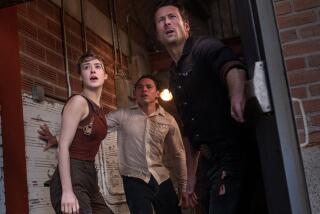The ante on Earth-in-peril movies gets upped...
- Share via
The ante on Earth-in-peril movies gets upped sharply this summer as the recently opened “Deep Impact” and “Armageddon” (July 1) hit theaters. Both movies are about the approach of giant meteors capable of destroying the Earth. (Pictured are Alexander Balvev, left, and John Favreau in a scene from “Deep Impact.”
Such cosmic events are not new for Hollywood. And while predicting when a meteor might hit is tricky business, it’s easier to forecast what this summer’s movies might be like by examining some of their ilk.
At some point early on, for example, someone is bound to utter the phrase “another Ice Age” or make reference to the disappearance of the dinosaurs as being meteor-related. At some point near the halfway mark, unexpected meteor fragments will hit Earth, giving all concerned a taste of the larger destruction to come.
Will past be prologue? Check out these comparisons of meteor movies--and keep your eye on the skies.
“THE BLOB” (1958)
The crisis begins when: A meteor plummets to Earth.
As a result: Earth’s existence is threatened by the gelatinous, expanding Blob inside the meteor that threatens to consume everyone and everything.
You know Earth is in trouble because someone says: “I don’t know what this is but it’s got to be killed before it gets any bigger.”
But you know Earth will survive because: A young, brooding Steve McQueen is leading the teens in the battle to eradicate the monster.
Sign of the times: After being forced to leave a movie before its conclusion to fight the Blob, one of McQueen’s friends grouses, “What a waste of 80 cents!”
Special effects: Unconvincing miniatures, cartoonish matte drawings.
Worst special effect: Not showing something being talked about. (In one scene, someone says, “Look, the diner is on fire,” but it is never shown.)
Earth is saved when: McQueen discovers that the Blob dislikes cold and musters an armada of CO2 fire extinguishers to subdue it.
“THE DAY OF THE TRIFFIDS” 1963)
The crisis begins when: Earth is treated to a meteor shower that’s like a forerunner of a Fillmore East light show.
As a result: Most people are blinded. Those who aren’t are chased by irradiated Triffid plants, which grow into giant, walking man-eaters.
You know Earth is in trouble because someone says: “Vast bands of Triffids are roaming the area.”
But you know Earth will survive because: Former MGM-musical star Howard Keel is one of the only people left in the world who can see.
Sign of the times: Keel’s Old Spice, Windjammer wardrobe.
Special effects: You can’t see the forest for the stuntmen dressed up as perambulatory trees.
Worst special effect: The sound the Triffids make when they move, like a cross between a wet bamboo wind chime and a straw sucking the bottom of a soda.
Earth is saved when: Someone discovers that seawater melts Triffids faster than you can say “Margaret Hamilton.”
“METEOR” (1979)
The crisis begins when: A previously undiscovered comet collides with a huge asteroid in outer space.
As a result: The asteroid careens into a collision course with Earth.
You know Earth is in trouble because someone says: “This could cause another Ice Age!”
But you know Earth will survive because: Scientist Sean Connery is battling bubble-headed government officials to take the correct action.
Sign of the times: Connery’s late-’70s longish hair and disco-era threads.
Special effects: Many portentous shots of the meteor hurtling through space. Though its speed is given as 30,000 mph, it seems to float.
Worst special effect: Stock footage of a building demolition, tinted orange to look as though it is exploding in flame from meteor impact.
Earth is saved when: Connery invents detente by convincing Russian and American governments to cooperate and jointly shoot nuclear missiles at the meteor.
“THE NIGHT OF THE COMET” (1984)
The crisis begins when: Earth passes through the tail of a huge comet.
As a result: Anyone who was not inside a steel structure either dies and turns to dust or becomes a rapidly deteriorating horror creature.
You know Earth is in trouble because someone says: “You haven’t seen those freaked-out zombies walking around?’
But you know Earth will survive because: The heroines are a pair of gun-toting karate-chopping cop’s daughters.
Sign of the times: Early MTV look. A soundtrack filled with generic rock, rather than recycled hits of the period.
Special effects: Consist mostly of numerous moody shots of empty L.A. streets to suggest the comet equivalent of the neutron bomb.
Worst special effect: Bad horror makeup creates a legion of zombies that look like Dan Aykroyd.
Earth is saved when: The teens outsmart the government and blow up their car with them in it.
“METEOR MAN” (1993)
The crisis begins when: A mild-mannered schoolteacher is hit by a glowing, green meteor while struggling with a street gang.
As a result: He develops super powers and helps to battle drug lords in an inner-city D.C. neighborhood.
You know Earth is in trouble because someone says: “Why did the meteor hit you? Because we need a real superhero.”
But you know Earth will survive because: This dreadful comedy has to end sometime.
Sign of the times: Director Robert Townsend casts such of-the-moment rap artists as Another Bad Creation and Kool Moe Dee as bad guys.
Special effects: Powers that include the ability to see through walls, super-speed and the power to touch a book and absorb all its knowledge in 30 seconds.
Worst special effect: The fact that Meteor Man can see through people’s clothes but only as far as their underwear, to save the PG rating.
Earth is saved when: “Meteor Man” dies a quick death in theaters and disappears to cable and video.
“ASTEROID” (TV; 1997)
The crisis begins when: The Fletcher comet swings within a million miles of Earth for the first time in more than a century.
As a result: A pair of giant asteroids traveling in its wake may strike Earth.
You know Earth is in trouble because someone says: “The effects would be global. The human race would be lucky to survive.’
But you know Earth will survive because: Astronomer Annabella Sciorra and emergency-management bureaucrat Michael Biehn are on the case.
Sign of the times: Everyone gets their information about the comet from cable TV, specifically CNN stand-in CNA.
Special effects: An artillery barrage of meteor fragments nearly destroys Dallas by creating a firestorm.
Worst special effect: A fleeing grandfather and grandson race through a hail of fiery meteorites that manage only to startle, rather than injure or consume, them.
Earth is saved when: American planes use lasers to fragment the asteroid that is aimed at Earth.
“DEEP IMPACT (1998) The crisis begins when: A student astronomer discovers an uncharted comet.
As a result: Comet is called Wolf-Biederman for him and his mentor; when it breaks in two, little comet is called Biederman and Earth-destroyer becomes big bad Wolf.
You know Earth is in trouble because someone says: The comet is “bigger than Mt. Everest-- over 500 billion tons” and utters the phrase “extinction-level event.”
But you know Earth will survive because: We’ve become progressive enough to elect Morgan Freeman president and to send Melville-reading astronaut Robert Duvall into space to blow up the comet.
Sign of the times: When veteran astronomer Wolf tries to warn thepowers-that-be about the comet via e-mail, he gets “Server Down” notice on his computer screen.
Special effects: Mammoth tidal wave from Biederman does to the East Coast with water what aliens did with fire in “Independence Day.”
Worst special effect: Though tidal wave is supposed to be moving at 1,100 milers-per-hour, Elijah Wood outruns it, both on a dirt bike and on foot.
Earth is saved when: (We could tell you, but we don’t want to ruin the film)
More to Read
Only good movies
Get the Indie Focus newsletter, Mark Olsen's weekly guide to the world of cinema.
You may occasionally receive promotional content from the Los Angeles Times.







